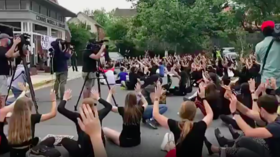Post-lockdown job recovery numbers are cooked, but not for the reason Paul Krugman & the never-Trumpers believe
The Trump administration has hailed new US jobs numbers showing a dip in sky-high unemployment rates as an economic victory, and the president’s enemies are crying foul. They’re right – but not for the reasons they think.
The president and his allies are hailing the addition of millions of jobs in Friday’s report from the Department of Labor as a sign the US has reversed the economic death spiral that began when state governments forced entire industries to close their doors in March due to the coronavirus pandemic.
Economists surveyed by Dow Jones had expected the unemployment rate to spike from 14.7 percent to 19.5 percent; instead, it declined to 13.3 percent. A predicted loss of 8.33 million jobs miraculously turned into a gain of 2.5 million. The expected “worst recession since the Great Depression” seemed to be receding into the rear-view mirror, sending the Dow up 800 points and Treasury yields surging. Trump himself tweeted in celebration.
It’s a stupendous number. It’s joyous, let’s call it like it is. The Market was right. It’s stunning! @jimcramer@CNBC
— Donald J. Trump (@realDonaldTrump) June 5, 2020
But not everyone was buying this fabulous recovery. New York Times economist Paul Krugman countered that Trump might have somehow “gotten to” the Bureau of Labor Statistics, apparently pressuring them into tweaking their numbers to reflect a growth in jobs numbers that doesn’t exist in real life.
Whatever happened, these numbers should make you more, not less, pessimistic about the economic outlook. Why? Because they will reinforce the White House inclination to do nothing and let emergency aid expire 4/ https://t.co/yoo3F6TAo0
— Paul Krugman (@paulkrugman) June 5, 2020
Lacking any proof for such allegations, he appeared to be hedging his bets in case the numbers were real, suggesting they should make Americans “more, not less pessimistic” because Trump would use them as an excuse not to pass the emergency aid still direly needed by many Americans. Close to 40 million people nationwide applied for unemployment in the months following the economic shutdown, and even if 2.5 million of those have returned to work or found new jobs, many more are still in need of relief.
A Nobel laureate, Krugman nevertheless seems to lack an understanding of labor statistics if he believes interference by the president is necessary to fudge the numbers needed to give the impression of a recovery. US unemployment rates have been thoroughly cooked for decades, leaving out millions of Americans who’ve never held jobs or have given up looking for work. A person who works two hours per week is counted as “employed” in the same way as a person who works 35 hours. Many presidents before Trump have held up seemingly rock-bottom unemployment numbers to burnish their economic bona-fides, even while large segments of the American population struggle to make ends meet – if they are able to find jobs at all.
Krugman’s decision to only now begin questioning official government employment numbers didn’t go unnoticed. Many pointed to an op-ed he’d written just five short years ago skewering so-called “employment truthers” – people doing exactly what Krugman was doing now. Others wondered why he’d been so willing to believe the statistics showing the loss of millions of jobs in the first place – only to decide the source was untrustworthy once it started reporting numbers that didn’t fit his narrative.
You in 2015: pic.twitter.com/MoDyF48jmH
— Yossi Gestetner (@YossiGestetner) June 5, 2020
So when the BLS reports that millions of jobs are lost in a month that's evidence that millions of jobs are lost in a month, but then when the BLS reports that millions of jobs were added, that's proof that Trump "got to the BLS"? Fascinating perspective there Paul
— Bongino Report (@BonginoReport) June 5, 2020
However, some skepticism is warranted surrounding the idea that Friday’s numbers represent a “recovery.” Half the reported job gains are in the leisure and hospitality sectors and likely consist of furloughed workers returning to their jobs as states relax their economic shutdown orders. It’s extremely unlikely these workers are back full-time, given that Americans have proven wary of returning to their pre-pandemic behavior. Smaller gains in the construction and manufacturing sector may also represent the return of laid-off workers to their reopened job sites. When the economic wound that triggered a recession is a self-inflicted one, merely reversing the self-injurious behavior (lockdowns, in this case) goes a long way toward beginning the healing process.
But buried in the rosy statistics are unpleasant truths about the nature of this “recovery.” Average hourly wages are down 6.7 percent from this time last year, indicating employers either can’t afford to pay workers their previous wages or have hired replacements at lower rates. And as the country remains in the grips of a protest movement spawned by the killing of an unarmed black man by a white police officer, the racial disparity in this “recovery” – black unemployment actually increased, edging up from 16.7 percent to 16.8 percent – is unlikely to quell unrest in the streets.
Like this story? Share it with a friend!














